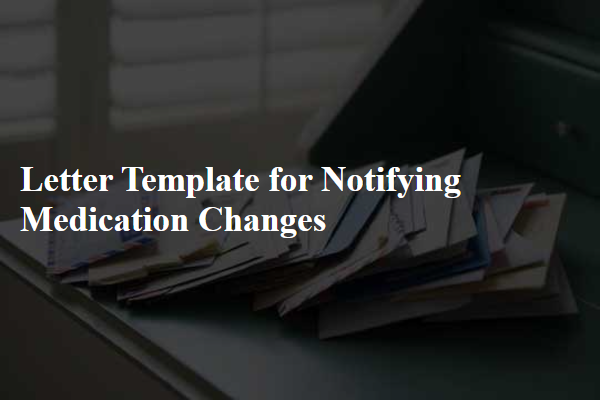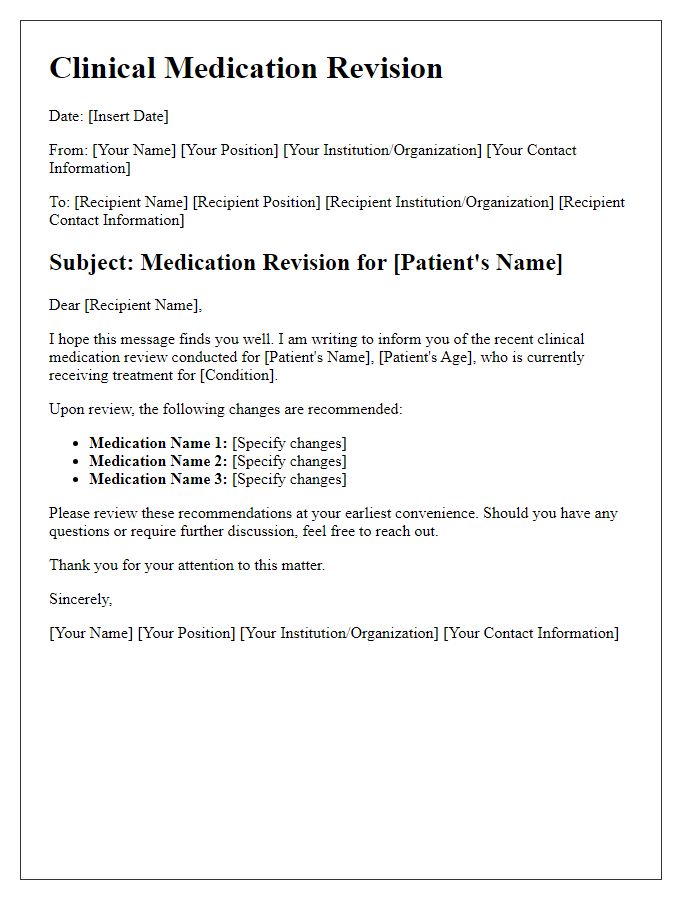Are you looking to notify someone about changes in their medication? It's essential to communicate these updates clearly and compassionately to ensure the recipient understands the importance of these adjustments. Whether for a loved one or a patient, providing details about the changes and reasons behind them can help ease concerns and foster better health management. Dive into our article to discover a versatile letter template that makes conveying these crucial updates easy and effective!

Patient Information
Patients receiving medication adjustments must be informed thoroughly to ensure safety and compliance. Detailed patient information should include the patient's name, date of birth, and identification number, providing clear identification. The new medication name, dosage (in milligrams or milliliters), frequency of administration, and the reason for the change, whether it's due to side effects or treatment efficacy, must be specified. Include the prescribing physician's name, contact information, and pharmacy details for prescription fulfillment. Additional notes may cover potential side effects to monitor and specific instructions for using the new medication, ensuring patients understand the importance of adhering to prescribed guidelines.
Medication Details
In medical facilities, accurate communication about medication changes is essential for patient safety. The medication details, including dosage and administration instructions, need to be clearly outlined. Pharmacological agents, such as antihypertensives, may be adjusted to target specific blood pressure readings (e.g., 120/80 mmHg). The introduction of a new medication, like Metformin for diabetes management, requires detailed notes on potential side effects (for instance, gastrointestinal issues such as nausea or diarrhea) and interactions with existing prescriptions (such as sulfonylureas). Healthcare providers should ensure that patients are informed about these changes promptly, ideally during follow-up appointments or through secure messaging systems, to maintain effective treatment regimens.
Reason for Change
Medication changes, often necessary for improved patient outcomes, can arise from various factors. Adjustments may stem from recent clinical guidelines established by organizations like the American Medical Association (AMA) or emerging research findings highlighting better treatment options. Patient tolerance to existing medications, such as common side effects or allergic reactions, may also prompt reevaluation. Dosage modifications could result from fluctuations in lab results, such as liver function tests or renal function indicators, which necessitate careful monitoring. Moreover, the introduction of newer pharmaceuticals, frequently assessed in peer-reviewed studies, can lead to changes in prescribed therapies to enhance efficacy or reduce adverse effects.
New Prescription Instructions
Updating medication protocols requires clear communication about new prescriptions to ensure patient adherence and safety. A recent change might involve transitioning from an oral medication, such as Metformin (commonly used for managing type 2 diabetes), to an injectable version like Insulin Glargine, which requires specific guidelines for administration. Additionally, patients may need monitoring for side effects, such as hypoglycemia, which can occur during the initial adjustment period. It is essential to provide comprehensive instructions detailing dosages, timing, and potential interactions with existing medications. Encourage follow-up appointments, ideally within two weeks, to assess the patient's response to the new regimen and adjust as necessary.
Doctor's Contact Information
A comprehensive notification regarding medication changes should include specific doctor contact information to ensure proper communication. The notification should feature the doctor's full name, professional title (such as MD or DO), and the medical practice or institution's name. It is important to list the clinic address, including street, city, state, and ZIP code, which aids in locating the healthcare provider. Additionally, include the primary phone number (preferably direct line) and any alternative contact numbers, such as a fax number or email address, for facilitating quick inquiries. Highlighting office hours adds clarity for patients seeking to discuss their medication adjustments. This thorough approach fosters effective communication, enhances patient care, and ensures all concerns can be promptly addressed.













Comments